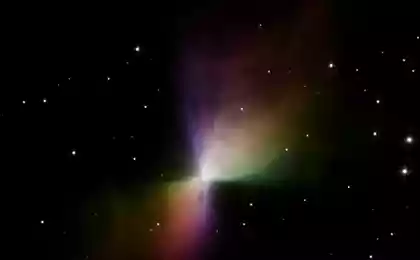523
Pulsar brighter than 10 million suns have surprised astronomers

The object, which scientists initially took for a black hole, actually turned out to be the most striking and strange pulsar that we have ever found. "This compact remnant of a small star — a real powerhouse," commented the find Fiona Harrison, Professor of physics at Caltech and principal investigator of the NuSTAR telescope.
"We have never seen anything like it. We thought that the object with such energy would have to be a black hole.
"The pulsar with such energy receives first prize for weirdness," says Dom Walton, a scientist who works with NuSTAR data.
Usual pulsars have a mass of one to two solar. The new pulsar presumably falls in that same category, but shines about 100 times brighter than theory suggests.
"We've never seen a pulsar even close to as bright", says Walton. — Honestly, we don't know how it happened, and theorists will be chewing this gum for a very long time."

Apart from its oddities, the discovery will help scientists to understand a class of very bright x-ray sources, called ultraluminous x-ray sources (ULX).
NuSTAR detection of the first ultraluminous pulsar was in detail described in the latest issue of Nature.
Big surprise "That was definitely unexpected discovery," says Harrison. — Actually, we were looking for something completely different, when I came across it."
Earlier this year, astronomers in London have recorded impressive supernova (SN2014J), which occurs only once in a hundred years, relatively close to our galaxy, Messier 82 (M82), or the Cigar galaxy, 12 million light years from Earth. Due to the rarity of this event, the telescopes around the world and the cosmos stared at the flash point, to really explore its implications.
Besides the supernova, M82 stores and a number of other ULX. When Matteo Bachetti from the University of Toulouse in France, lead author of the new work, decided to consider these ULX in the NuSTAR data, he discovered something strange pulsating or flashing light in the galaxy.
"It was a big surprise," says Harrison. — For decades everyone thought these ultraluminous x-ray sources constitute black holes. But black holes do not pulsate".
But pulsars can. They are like giant magnets that emit radiation from their magnetic poles. As their rotation outside observer with an x-ray telescope, situated at a right angle, will see flashes of powerful light as the rays will periodically get into the field of view of an observer, like the light of the lighthouse.
Not black and not a hole the Reason most astronomers had assumed black holes are the source of ultraluminous x-ray sources, is the incredible brightness of these sources. Black holes can be ten or a billion times the Sun's mass, making their gravitational pull is much stronger than that of the pulsar.
As material falls onto the black hole the gravitational energy turns it to heat, which creates x-ray light. The larger the black hole, the more energy that causes the object to Shine. Was surprised to find flashes coming from M82, the NuSTAR team started to check and recheck data. The flashes were really there, one pulse in every 1.37 seconds.
The next step was figuring out what the x-ray source could produce such outbreaks. The researchers analyzed data from NuSTAR and a second NASA x-ray telescope, Chandra, to rule out about 25 different x-ray sources, and finally stopped at ultracom-ray source M82X-2.
After it was determined the pulsar and its location within M82, there are still many unanswered questions. Pulsar is many times greater than the Eddington limit, a basic rule in physics, which sets a limit on the luminosity that can reach the object with a certain mass.
"This is the most cruel violation of this limit, we have seen," says Walton. We know that the limit can be violated to a small value, but our finding just blows it".
NuSTAR is well prepared for discoveries like this. Besides the fact that space telescope sees high-energy x-rays, he still sees them in a unique way. Instead of doing shots, so how does your phone camera — when the picture is blurred when you move — NuSTAR detects individual particles of x-rays and notes them when measures. This allows the team to do timely analysis, and in this particular case, to see when the light from the ULX comes in the form of pulses.
Now that the NuSTAR team has shown that this ULX is a pulsar, Harrison points out that many other ultraluminous x-ray sources also could be pulsars.
"Everybody assumed that these sources are black holes," she says. "I think that people need to go back to the drawing Board and think again. Perhaps our finding is a unique and strange object, and they may not be so rare. While we don't know. Further observation will tell."
Source: hi-news.ru























